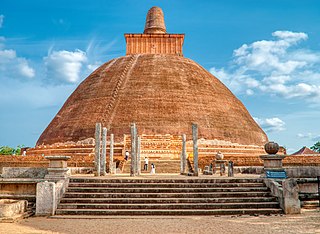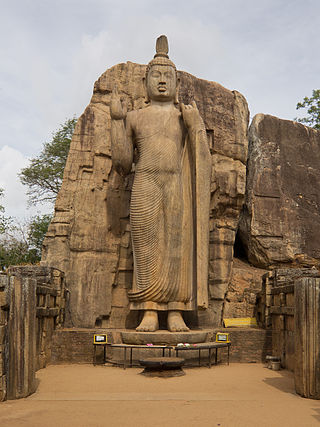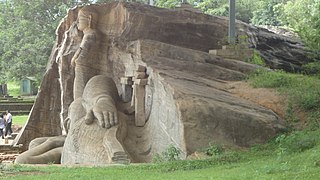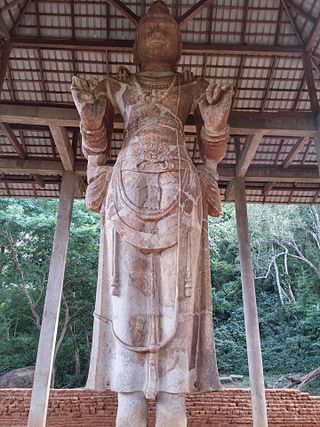
Sri Lankabhimanya Ranasinghe Premadasa was the third President of Sri Lanka from 2 January 1989 to his assassination in 1993. Before that, he served as the Prime minister of Sri Lanka from 6 February 1978 to 2 January 1989. Premadasa is considered as the longest serving uninterrupted Prime Minister of Sri Lanka by serving in that post for nearly 11 years. He was the first person conferred Sri Lanka's highest civilian award Sri Lankabhimanya in 1986 by President J. R. Jayewardene.

Jaya Sri Maha Bodhi is a historical sacred bo tree in the Mahamewuna Garden in historical city of Anuradhapura, Sri Lanka. This is believed to be a tree grown from a cutting of the southern branch from the historical sacred bo tree, Sri Maha Bodhi, which was destroyed during the time of Emperor Ashoka the Great, at Buddha Gaya in India, under which Siddhartha Gautama (Buddha) attained Enlightenment. The Buddhist nun Sangamitta Maha Theri, a daughter of Indian Emperor Ashoka, in 236 BC, brought the tree cutting to Sri Lanka during the reign of Sinhalese King Devanampiya Tissa.[1] At more than 2,300 years old, it is the oldest living human-planted tree in the world with a known planting date. The Mahavamsa, or the great chronicle of the Sinhalese, provides an elaborate account of the establishment of the Jaya Siri Maha Bodhi on the Island and the subsequent development of the site as a major Buddhist pilgrimage site.

The Jetavanarama stupa or Jetavanaramaya is a stupa, or Buddhist reliquary monument, located in the ruins of Jetavana monastery in the UNESCO world heritage city of Anuradhapura, Sri Lanka. At 122 metres (400 ft), it was the world's tallest stupa, and the third tallest structure in the world when it was built by King Mahasena of Anuradhapura (273–301). He initiated the construction of the stupa following the destruction of the Mahaviharaya of Anuradhapura. His son Kithsirimevan completed the construction of the stupa, and it was renovated by Parakramabahu I of Polonnaruwa. A part of a belt tied by the Buddha is believed to be the relic that is enshrined here.

The Samadhi Buddha is a famous statue situated at Mahamevnāwa Park in Anuradhapura, Sri Lanka. The Buddha is depicted in the position of the Dhyana Mudra, the posture of meditation associated with his first Enlightenment. This statue is 7 feet 3 inches in height and carved from dolomite marble.. It is similar to the Toluvila statue from the same period. It is similar to Gupta period Buddha images, it is believed that originally the image was gilded and had inlaid eyes made of precious gems. It is likely that it was one of the four statues around a sacred Bodhi tree shrine. This is the only one that has survived largely intact.

The Avukana statue is a standing statue of the Buddha near Kekirawa in North Central Sri Lanka. The statue, which has a height of more than 14 m (46 ft), depicts the Buddha with a hand raised in reassurance, a variation of the Abhaya mudra. The Avukana statue is one of the best examples of a standing statue built in Sri Lanka. It is now a popular tourist attraction.
The ancient Sri Lankan people excelled in the construction of tanks (Wevas) or reservoirs, dagobas, and palaces in Sri Lanka, as evident from the ruins which displays a rich variety of architectural forms.

The Gal Vihara, and known originally as the Uttararama, is a rock temple of the Buddha situated in the ancient city Polonnaruwa, the capital of the ancient Kingdom of Polonnaruwa, now present-day Polonnaruwa, in North Central Province, Sri Lanka. It was fashioned in the 12th century by King Parakramabahu I. The central feature of the temple is four rock relief statues of the Buddha, which have been carved into the face of a large granite gneiss rock. The images consist of a large seated figure, another smaller seated figure inside an artificial cavern, a standing figure, and a reclining figure. These are considered to be some of the best examples of ancient Sinhalese sculpting and carving arts, and have made the Gal Vihara the most visited monument at Polonnaruwa.

Buduruwagala is an ancient Buddhist temple in Sri Lanka. The complex consists of seven statues and belongs to the Mahayana school of thought. The statues date back to the 10th century. The gigantic Buddha statue still bears traces of its original stuccoed robe and a long streak of orange suggests it was once brightly painted. The central of the three figures to the Buddha's right is thought to be the Buddhist mythological figure-the Bodhisattva Avalokitesvara. To the left of this white painted figure is a female figure in the thrice-bent posture, which is thought to be his consort-Tara.
Dhatusena was a king of Sri Lanka who reigned from 455 to 473 AD. He was the first king of the Moriyan dynasty. In some records, he is also identified as Dasenkeli. Dhatusena reunited the country under his rule after twenty six years of anarchy, defeating the six Dravidians that were ruling the country at that time. Dhatusena built large reservoirs and canals to augment the agriculture in the country.

Maligawila, or Maligavila is a village in Sri Lanka, approximately 15 kilometers (9.3 mi) south from Monaragala and 9 kilometers (5.6 mi) from Okkampitiya in the Monaragala District. It is the site of several important archaeological pieces, including a free-standing 11 meters or 12 meters tall limestone statue of Buddha, claimed in some quarters to be the tallest free-standing statue of Buddha in the world, though the Avukana Buddha Statue is also said to be taller. This Buddha draws many tourists to the region. It also boasts the Avalokitesvara statue, a 10 meters limestone portrait. These statues, which were discovered in the 1950s and restored between 1989 and 1991, are believed to have been commissioned by the 7th-century prince Agghabodhi. There is additionally a 10th-century historical pillar placed in the 10th year of the rule of Mahinda IV.

Anuradhapura Kingdom, named for its capital city, was the first established kingdom in ancient Sri Lanka related to the Sinhalese people. According to the Mahāvaṃsa, it was founded by King Pandukabhaya in 437 BC, whose authority extended throughout the country.

Kataragama deviyo is a guardian deity of Sri Lanka. A popular deity who is considered to be very powerful, shrines dedicated to Kataragama deviyo are found in many places of the country. Sinhalese Buddhists believe him also as a divine patron of the Buddha Sasana in Sri Lanka. An ancient temple dedicated to God Kataragama, known as Ruhunu Maha Kataragama Devalaya is situated in the South-Eastern town of Kataragama in Monaragala District of Uva Province.

The Polonnaruwa Vatadage is an ancient structure dating back to the Kingdom of Polonnaruwa of Sri Lanka. It is believed to have been built during the reign of Parakramabahu I to hold the Relic of the tooth of the Buddha or during the reign of Nissanka Malla of Polonnaruwa to hold the alms bowl used by the Buddha. Both these venerated relics would have given the structure a great significance and importance at the time. Located within the ancient city of Polonnaruwa, it is the best preserved example of a vatadage in the country, and has been described as the "ultimate development" of this type of architecture. Abandoned for several centuries, excavation work at the Polonnaruwa Vatadage began in 1903.
The 2010–11 Inter-Provincial Limited Over Tournament will be the third season of the official Limited overs domestic cricket competition in Sri Lanka. It will be a shorter tournament compared to the previous one with only 13 matches, and all group matches being held at the Sinhalese Sports Club Ground and all three finals at the newly upgraded R. Premadasa Stadium also in Colombo. This edition featured the Uva cricket team's debut in the limited overs tournament of the Inter-Provincial Cricket Tournament, having previously featured in the Inter-Provincial First Class Tournament. This season also saw the introduction of the Basnahira cricket team with the merger of Basnahira North and Basnahira South cricket teams. It will be the first time that the five teams represent five different provinces in the tournament.

The Sri Lanka Maha Bodhi Centre is a Sri Lankan Buddhist establishment in Chennai, India. It is located in Egmore. It is run by the Sri Lanka Maha Bodhi Society and serves as a monument of friendship between Sri Lanka and India.
Mahinda II was King of Anuradhapura in the 9th century, whose reign lasted from 787 to 807. He succeeded Aggabodhi VII as King of Anuradhapura and was succeeded by his son Dappula II. His father was King Aggabodhi VI.
Buddhavanam is a tourism project in Nagarjuna Sagar, Telangana created by the Telangana State Tourism Development Corporation. The project was sanctioned by the Government of India viz., Integrated Development of Nagarjunasagar as part of Lower Krishna valley Buddhist circuit with a view to attract large number of domestic and foreign tourists particularly from the South-East Asian countries.
The following lists events that happened during 1993 in Sri Lanka.

Sri Maha Bodhi Viharaya is a Theravada Buddhist temple in Kandy, Sri Lanka. It is located in Bahirawakanda, approximately 2 km (1.2 mi) from the city centre. The temple is known for its giant Buddha statue. The statue of Buddha is depicted in the position of the Dhyana Mudra, the posture of meditation associated with his first Enlightenment, and can be seen from almost everywhere in Kandy. It stands at 26.83 m (88.0 ft) high and is one of the tallest Buddha statues in Sri Lanka.













